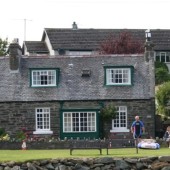Part 3
 In the village there was at one time an estate joiner and blacksmith, two tailors, two shoemakers and two weavers, one for wool and one for linen. The man who wove the linen was famed all over for his patterns. The tailors used to travel from farm to farm plying their trade. No such tradesmen live and work here now, and all these goods are made and bought elsewhere.
In the village there was at one time an estate joiner and blacksmith, two tailors, two shoemakers and two weavers, one for wool and one for linen. The man who wove the linen was famed all over for his patterns. The tailors used to travel from farm to farm plying their trade. No such tradesmen live and work here now, and all these goods are made and bought elsewhere.
There is a slate quarry at Tayvullin from which came the slates for the roofs of many of the local houses. Not all were so used however, and the soil in the garden at Taynish House is said to have come over from Ireland as ballast in the boats which sailed over to buy and take away the Tayvullin slates.
Taynish is perhaps the oldest of the lairds’ houses in the neighbourhood. The central portion was built in 1650 and rather more than a hundred years later the rounded ends that give the house its special character and charm were added. It was destroyed by fire some years ago, but has been restored, though at present used only as a holiday residence. A smaller house was built by the owners nearer the village within a year or two of the fire. Dr MacCormack, the well known surgeon, was born at Taynish. At one time the proprietor of Taynish, owned most of the land from the point of Danna to well north of the village, where the estate marched with that of Poltalloch at Gallichoille. Within the last hundred years many parts were sold and the estate is now confined to the Taynish peninsula, ending at Auchentenavil just south of the village.
Scotnish estate was at one time part of Taynish and was bought from the Inverneill family, a mansion house designed by a pupil of Sir Robert Lorimer being built there in 1912. This house stands on a beautiful site overlooking Caol Scotnish, and has a fine garden of shrubs round it.
Keills House was built about the turn of the century, and has since been sold; a member of the family now lives in a contemporary house erected only a few years ago.
Carsaig House, Torgorten, Inchjura and Dalnaheish were all put up about the same time, but the Free Church Manse is of earlier date. Probably none of the houses we have mentioned are as old as some of the cottages in and near the village, a few of these may date so far back that one cannot be sure when they were built. The Free Church itself at one time stood on the opposite side of the road to the manse but was pulled down in 1899 and a new church built in the village. The manse has now been sold and the Minister lives in a new house very near the site of the old church. The present Church of Scotland was built in 1900. The burial ground for this district is at Carsaig, and is called Cam Coinneach, or Kenneth’s Tomb, the name originating from the following story.
In the reign of James VI, Kenneth Maclean of Mull landed on this coast to avenge a quarrel he had with the MacNeill of Taynish. Having killed MacNeill, he drove off the Taynish cattle and brought them to Carsaig, whence they could be ferried across to Mull. Graham, the laird of Oib, wishing to revenge MacNeill’s death, followed Kenneth to Carsaig and accused him of the killing. Kenneth replied aggressively, and Graham then said to him: ‘Look at that beautiful ship in full sail coming down the Sound of Jura.’ Kenneth turned his head to look, whereupon Graham drew his dagger and thrust it in Maclean’s side so that he fell dead and was buried at that place.








_baef36edc53bdd009ca06069d3b23fda.jpg)





